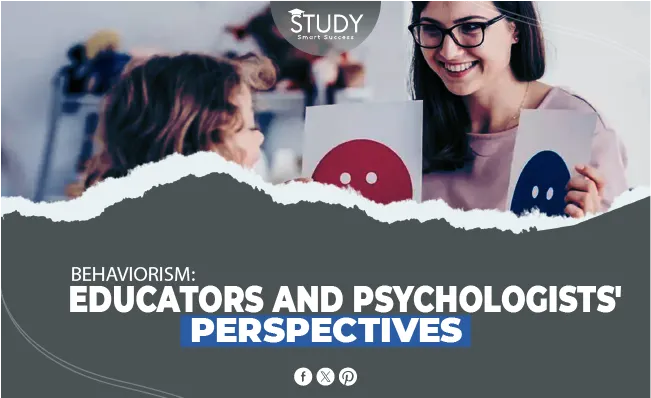Introduction
Brief overview of behaviorism
Behaviorism is a psychology theory that emphasizes external behaviors over internal ones. It acquired popularity in the early 20th century thanks to Ivan Pavlov, John B. Watson, and B.F. Skinner. Behaviorism holds that environmental inputs and reinforcement may anticipate, control, and understand behavior. For more details about Humanistic Theory.
Importance of Understanding Behaviorism in Education and Psychology
Psychologists and educators must understand behaviorism. Behaviorist ideas guide teaching and learning interventions to foster student progress. Behaviorism has shaped psychology’s therapeutic techniques and interventions, revealing human behavior and motivation. Behaviorism may teach educators and psychologists how people learn, adapt, and prosper in varied contexts.
Understanding Behaviorism
Definition and Key Concepts
Behaviorism is a way of thinking about psychology that focuses on how actions can help us understand how people and animals act. It says that behaviors are learned responses to things in the world and that the study of mental processes inside the mind is not the point. Some important ideas are reinforcement, conditioning, and stimulus-response links.
Historical Background and Prominent Figures (e.g., Pavlov, Watson, Skinner)
Behaviorism gained popularity in the early 20th century thanks to Ivan Pavlov, John B. Watson, and B.F. Skinner. Pavlov’s classical conditioning research showed animals could correlate neutral stimuli with reflexes. Watson emphasized observable behaviors and rejected internal mental processes to advance behaviorism. Skinner’s operant conditioning study stressed reinforcement’s influence on behavior.
Basic Principles of Behaviorism
Behaviorism is guided by several fundamental principles:
- Observable behaviors: Behaviorists are more interested in behaviors that can be seen and measured than in mental processes or subjective feelings.
- Stimulus-response associations: Behaviors are learned by making connections between what happens and how we react to it. This is what classical training is based on.
- Reinforcement: Behaviors are reinforced or diminished by their results. Punishment reduces conduct, but positive reinforcement promotes it.
- Conditioning: Learning happens through conditioning, which links inputs to responses. Operant conditioning involves voluntary actions and consequences, while classical conditioning involves involuntary responses.
Behaviorism in Education
Application of Behaviorism in Teaching and Learning
Behaviorism’s emphasis on environmental inputs and reinforcement has shaped education and learning. Education uses behaviorist ideas to improve learning environments and student learning. Teachers enhance student engagement, participation, and academic performance using behaviorist methods.
Behaviorist Teaching Strategies and Techniques
Behaviorists use reinforcement and training to get kids to do what they want. Here are some standard techniques:
- Positive reinforcement: They use praise, gifts, or special rights as rewards or incentives to get people to behave as you want them to.
- Negative reinforcement: They were getting rid of unpleasant stimuli to make wanted behaviors more likely, like giving less homework for doing classwork.
- Prompting and shaping: Prompting students to behave in a certain way and gradually changing their answers so they do what you want them to do.
- Behavior contracts: They were creating teacher-student agreements with expectations and consequences.
Examples of Behaviorist Approaches in Educational Settings
Behaviorist approaches are evident in various aspects of educational settings, including:
- Classroom management: Setting clear routines and expectations, giving quick feedback, and using reinforcement techniques to encourage good behavior.
- Teaching methods: Using repetitive drills, practice exercises, and structured activities reinforces learning and promotes skill acquisition.
- Assessment and feedback: Providing timely feedback and using reinforcement techniques to motivate students to improve performance.
- Individualized interventions: Implementing behavior modification plans or individualized education plans (IEPs) to address specific learning or behavioral needs of students.
By using behaviorist ideas in the classroom, teachers can create supportive learning environments that encourage student involvement, motivation, and academic success.
Behaviorism in Psychology
Behaviorism’s Impact on the Field of Psychology
Behaviorism has shaped psychology’s theoretical frameworks, research techniques, and practical practices. Behaviorism questioned psychology’s focus on internal mental processes by emphasizing observed behaviors and environmental factors. It’ concepts enabled systematic techniques to analyzing and changing behavior, advancing learning theory, behavior therapy, and behavioral neuroscience.
Behaviorist Theories of Learning and Behavior Modification
Behaviorist learning theories emphasize the role of conditioning and reinforcement in shaping behavior. Two primary theories include:
- Classical conditioning: According to Pavlov, classical conditioning uses neutral stimuli and reflex reactions to teach behavior. For example, pairing a bell with food can make the dog salivate at the sound alone.
- Operant conditioning: Operant conditioning, developed by Skinner, emphasizes behavior consequences. Reinforced behaviors are repeated, but punished or unreinforced ones are not. This notion underpins behaviormodification to increase desired behaviors and decrease unwanted ones.
Case Studies illustrating Behaviorist Interventions in Psychological Therapy
Psychological therapy has successfully treated behavioral and emotional issues using behaviorist approaches. Effective behaviorist methods are shown in case studies:
- Systematic desensitization: Systematic desensitization reduces anxiety by gradually exposing feared stimuli and relaxing.
- Token economies: Token economies, used in schools and psychiatric hospitals, reward desired actions with tokens or points.
- Applied behavior analysis (ABA): ABA analyzes behavior, identifies functional links, and implements treatments to improve adaptive and decrease maladaptive behaviors.
These case studies show how behaviorist therapies can improve behavior and function in various psychological conditions.
Criticisms and Limitations of Behaviorism
Lack of Consideration for Internal Mental Processes
Behaviorism is criticized for ignoring thinking, emotions, and cognition. Behaviorism ignores human cognition and subjective experiences, focusing instead on observable behaviors and environmental cues. Critics say this restricted focus hinders our understanding of human behavior and ignores internal influences.
Ethical Concerns Regarding Behaviorist Practices
Behaviorist approaches raise ethical questions about autonomy, coercion, and manipulation. Critics argue that behaviorist methods like punishment and reinforcement are coercive and may violate human rights. Aversive stimuli or punishment-based remedies also raise ethical concerns about risk and long-term psychological repercussions.
Alternative Perspectives in Education and Psychology
Despite behaviorism’s contributions to education and psychology, other viewpoints offer diverse perspectives on behavior and cognition. Cognitive psychology, which studies internal mechanisms and information-processing methods, emphasizes human perception, memory, and problem-solving. Behaviorism views learning as a passive response to external stimuli, but constructivism emphasizes learning and knowledge-building through environmental interaction.
Humanistic educational approaches emphasize individual needs, self-actualization, and intrinsic motivation, promoting student-centered learning and autonomy. Psychodynamic and humanistic psychology stress unconscious urges, subjective experiences, and interpersonal relationships in influencing behavior and personality.
While behaviorism is still helpful in understanding behavior and learning, considering these viewpoints enriches our understanding of human nature and informs more holistic education and psychology.
Contemporary Applications and Adaptations
Integration of Behaviorism with other Theories (e.g., Cognitive-Behavioral Therapy)
Behaviorism is sometimes used with cognitive-behavioral therapy. Behaviorist and cognitive ideas are used in CBT to treat many psychological disorders.
CBT helps people identify and change maladaptive behaviors and mental processes by concentrating on both. This integrative method treats anxiety, depression, and substance misuse well.
Modern Advancements in Behaviorist Research and Practice
Behaviorist research and practice have evolved with technology and research methodologies. Behavioral neuroscience investigates the neurological underpinnings of behavior and learning, revealing the biological basis of behaviorism.
Applied behavior analysis (ABA) uses behaviorism, empirical research, and evidence-based practices to address complex behavioral issues in people with autism spectrum disorder and other developmental disabilities.
Conclusion
Recap of Key Points Discussed
We’ve reviewed behaviorism’s definition, essential concepts, historical context, famous people, and uses in education and psychology. We’ve covered behaviorist education, learning, behavior modification, psychological therapy, and its drawbacks. We also highlighted modern applications, such as theory integration and research and practice advances.
Importance of considering Behaviorism in both Education and Psychology
Psychologists and educators must understand behaviorism to comprehend learning, motivation, and behavior. Behaviorist principles drive classroom management, teaching, and student growth.
Psychologists use behaviorism to analyze, change, and enhance behavior. Behaviorism can assist teachers and psychologists in employing evidence-based techniques to help children succeed.
Future Directions and Possibilities for Further Exploration
The future holds intriguing chances to explore and integrate behaviorism with other theoretical viewpoints and emerging technology. Research in behavioral neuroscience, cognitive science, and applied behavior analysis can improve our understanding of human behavior and cognition.
Innovative uses of behaviorist ideas in artificial intelligence, virtual reality, and digital health offer new ways to influence behavior and improve outcomes across different populations. By collaborating across disciplines and using new technologies and research, we may use behaviorism to solve complex social problems and enhance human well-being.


